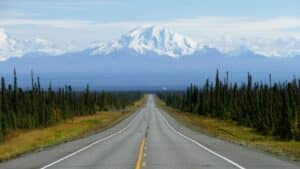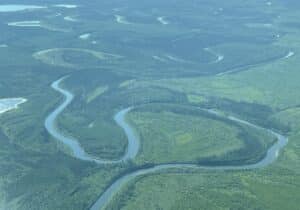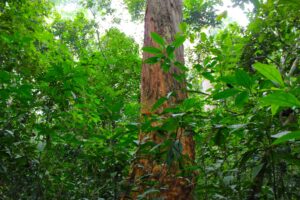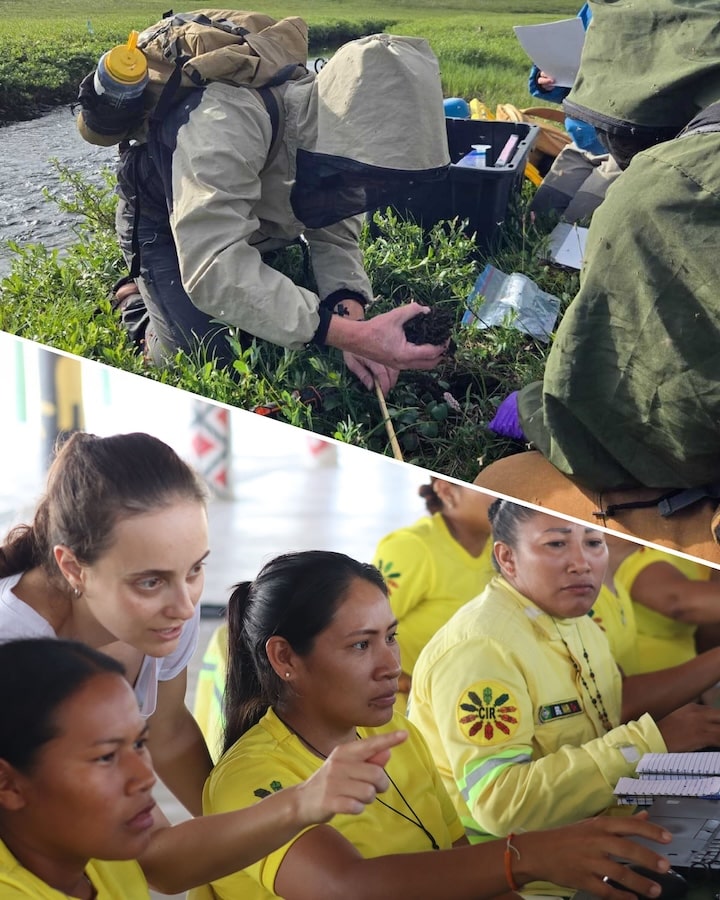The 100-year flood event currently impacts more than 840,000 structures and causes greater than $1.47 billion (2025 USD) in building damages across Ethiopia, according to a country-wide climate change risk assessment from the Woodwell Climate Research Center. The report, titled “Climate Risk Assessment: Ethiopia,” was released May 14 and offers granular projections on risk factors that will impact Ethiopia’s communities over the coming decades.
“Ethiopia faces big climate risks like droughts, extreme rainfall, unreliable stream flows, and floods, but they’re not impossible to overcome. By using robust data, focusing on communities, and taking a joined-up approach (like Woodwell Climate Research Center suggests), Ethiopia can become more resilient and create a sustainable future for everyone. The time for action is now,” said Professor Engdawork Assefa with the Center for Environment and Development at Addis Ababa University.
“The climate risk assessment enhances Ethiopia’s capacity to take targeted action, boosting its national climate goals under NDC 3 and supporting its case for equity in Loss and Damage frameworks. By offering a scientific foundation, it enables Ethiopia to strategically direct investments, policies, and partnerships toward a resilient future,” said Abas Mohammed with the Ethiopian Ministry of Planning and Development.
The assessment, completed in collaboration with the Addis Ababa University and Ministry of Planning and Development, reveals that climate change will reshape weather patterns across Ethiopia, posing challenges to water availability for agriculture and flooding in the built environment. Key findings include:
- Drought Risk: Extreme drought risk is projected to increase moderately in southeastern Ethiopia by 2050 and significantly in northwestern Ethiopia by 2070, with some communities seeing a 10-year drought becoming a 5-year drought.
- Streamflow Changes: Mean annual streamflow volumes in north central Ethiopia are projected to more than double, with the annual 7-day mean maximum flows projected to be 2-2.5 times larger at key measurement points by 2050.
- Extreme Precipitation: The historical 100-year rainfall amount is projected to increase 20%-30% by 2050 and 30%-40% by 2070 for the majority of Ethiopia, with the probability of the current 100-year event at least doubling by 2050.
- Flood Impact: The 100-year flood currently impacts more than 840,000 structures and causes greater than $1.47 billion (2025 USD) in building damages, with risk concentrated in the central Rift Valley and Somali region.
“Climate shocks threaten food security, yet targeted investments in closing the yield gap—through improved seeds, irrigation, livestock practices, market access, and insurance—can help mitigate crisis impacts.,” said Dr. Abay Yimere, CEO of African Climate Center for Adaptation and Mitigation and Woodwell collaborator.
The report underscores that while Ethiopia has established a strong policy landscape for climate action through several strategic initiatives, including the National Adaptation Plan (NAP) and the Climate Resilient Green Economy Strategy (CRGE), localized data insights are crucial for evidence-informed approaches to resilience.
“Ethiopia has done excellent work on climate research and resilience, and it is an honor to be able to support those efforts with our science,” said Woodwell President Dr. Max Holmes. “We hope that this risk assessment will help our Ethiopian government partners prepare for additional climate change impacts and invest in adaptation.”
Upcoming Workshop to Share Climate Analysis Skills
In conjunction with the report launch, Woodwell will host a capacity-sharing workshop after the report delivery in Addis Ababa. The workshop will provide participants with technical skills in climate data analysis fundamentals, including QGIS exercises and Google Earth Engine techniques.
“Knowledge sharing and growing capacity is a crucial part of building climate resilience,” said Dom Dusseau, Lead Author on the report who will be facilitating portions of the workshop. “I am very excited for the bi-directional skill transfer that will be taking place.”
The full-day workshop will include hands-on exercises, discussions on climate analysis methodologies, and resources for continued learning.
Cost estimates rising for permafrost-related damage to Alaska roads and buildings
Better knowledge and mapping of existing infrastructure is leading to a new estimate of future thaw costs under varying climate scenarios

Permafrost thaw is expected to impose costs of $37 billion to $51 billion to Alaska roads and buildings through the middle of the century, according to a newly published study.
The calculated toll, detailed in a study published in the journal Nature Communications Earth and Environment, is higher than previous estimates of thaw costs to Alaska permafrost. That is because of a more complete inventory of roads, buildings and structures like storage tanks, made possible by improved satellite imagery and other technology, said lead author Elias Manos of the University of Connecticut.
My first attempt at using Woodwell’s new Total Organic Carbon (TOC) analyzer began with a week of performing potassium chloride (KCl) nutrient extractions on 120 soil samples , and abruptly ended when the analyzer immediately failed to accurately measure total nitrogen correctly. While this disruption was frustrating, experiencing setbacks is a common part of lab work.
Woodwell Climate Research Center has four labs used by researchers to prepare and analyze soil, plant, gas, and water samples. In the preparation labs, scientists spend hours filtering, treating, extracting, and grinding samples, usually hundreds at a time. My job involves doing biogeochemical analyses on soils and water to understand how nutrients and greenhouse gasses are affected by different land management practices. The projects that I have worked on include studying the role of cover crops on soil health, exploring the impacts of tropical agriculture on reservoir dynamics, and the impacts burning of arctic tundra on nutrient availability. As a result, I have become extremely familiar with the breadth of complex assays that Woodwell Climate’s labs offer.
Performing these tasks can feel tedious, and facing boxes upon boxes of samples can be daunting. But when I put on some R&B and dig in deep, I’m able to transform the work into more of a meditation. Suddenly the rhythm of the music aligns with my pipetting, or how I change out samples while weighing, or my pace when cleaning and preparing materials for the next batch of samples. Recently, I spent an entire week grinding 500 soils for Woodwell Climate Carbon Program Director, Dr. Jon Sanderman’s Rangeland project. In the beginning, it was a little awkward finding the best approach to the grinding/cleaning dichotomy, which involves filling capsules with dirt, loading them onto a shaking instrument for grinding, storing the ground samples, then spending a decent amount of time cleaning up for the next set. With time, though, I caught a groove and the work became almost muscle memory.
Once the preparation steps are complete, the samples are ready for analysis on our sophisticated instruments, which measure greenhouse gasses, nutrients, carbon and nitrogen levels, and other soil and water qualities. Analysis might seem like the more complex aspect of our work, but between automation and well-developed methods, data collection can be as simple as loading samples into the apparatus and pressing start.
However, sometimes the instruments misbehave, and that’s where my biggest challenges begin. Troubleshooting is a very open ended process, so knowing where to start requires experience and in-depth understanding of the instrument. The answer to a problem can come from the manual, other lab users, or tech support, and often encountering an unfamiliar error can be the best way to learn the intricacies of equipment, and ultimately new skills. Since joining this lab, I have learned a good deal about electronics by having to check the performance of, and occasionally replace, components such as fusion boards, distribution boxes, and fuses. Similarly, software engineering has become less elusive to me. Familiarity with these and similar aspects of our instruments allows lab members the ability to restore harmony when they begin to misbehave.
Despite the challenges, lab work is really fulfilling. Watching the seemingly endless queue of samples dwindle down to nothing is gratifying, and the data produced can provide long-anticipated answers to some of our biggest research questions. Trial and error is a tried and true way to learn, so needless to say, a lot of learning occurs in the lab. Lab results are rewarding by nature, because they drive the important work done at Woodwell Climate, but after an uphill battle, they become much more gratifying. Struggling with an instrument only increases my appreciation for smooth sailing and working through so many samples reminds me of the thorough research that all our scientists are doing every day. My work may seem aggravating at points, but it is very much worthwhile for the greater mission of mitigating climate change.
Lab Operations and Field Safety Manager, Steve Gaurin oversees the operations of Woodwell Climate’s four lab spaces, running them efficiently and effectively so researchers can generate the data they need for their studies. His day to day job involves regular maintenance on the complex machinery, troubleshooting glitches, maintaining safety procedures, and ensuring the Center’s scientists have the required materials to analyze samples and collect data. Here, Gaurin discusses what it actually takes to keep the lab running in top form.
SR: So, Steve, tell me about the Woodwell Lab.
SG: The lab is an essential piece of any research that takes place at the Center. It’s incredibly important to ensure our data is accurate and generated by reliable instruments; that’s a big part of my job.
We have four lab spaces at the Center— the main lab on the 3rd floor, our basement lab which is mostly used for soil sample prep, the gas chromatograph room, and somewhat disused at present, the shed lab.
SR: What do you wish more people knew about lab operations?
SG: The amount of effort and time and energy it takes to keep all these instruments running. They are incredible pieces of technology, but they’re also quite complicated, and there’s a number of different ways that they can go wrong. And they do. So when I say in a staff meeting, “all the instruments are working well” that’s a real statement, because it’s not always the case.
SR: And when problems with the instruments do pop up?
SG: It takes a lot of problem solving, almost like detective work to get to the bottom of it.
SR: Do you enjoy detective work?
SG: I enjoy it when we figure it out. Then it’s like one of the best feelings of my day. It feels like a triumph. The research assistants are happy, the PIs are happy. I’m happy. Everything’s good.
SR: But I take it we don’t always figure it out?
SG: Yeah, as I mentioned, these instruments are incredibly complex, and there are a number of ways that they can fail. For example, one of the soil analyzers, it has so many different O rings at all its connection points and if any one of those O rings is a little bit askew, it’s going to fail a leak test. Or the problem could be the flange seal at the top of the combustion tube. Or any number of things. Even though it seems like these things are simple input-output devices, the technology, the electronics, the chemistry, the physics, everything that went into those is nothing short of remarkable.
SR: Sounds like it’s a tall order to keep all these complicated instruments running.
SG: It’s not just me. Any time that I’m trying to solve a problem with anything in the lab, I’m working with the research assistants. And in many cases, it’s those discussions and those interactions with them that really get to the heart of the problem—and to the solution. In our last case with the nutrient analyzer, it was a lot of sleuthing from Andie Norton that really identified the problem. It’s essential to have the input and ideas of the people who really run the instruments most often.
SR: The lab, I imagine, also requires a lot of material resources to keep running.
SG: Yes. Most of the instruments run in the range of, say, 50 to 80 thousand dollars new. As we purchase new instrumentation, we also purchase service contracts for preventative maintenance visits and access to a technician, which is also incredibly valuable for troubleshooting. The other thing these instruments also need is consumables. You constantly need to be ordering those as supplies get depleted—chemicals, gas cylinders and the like. It’s not cheap but it’s crucial.
SR: What are your goals for the future of the lab?
SG: I think that the main goals for the lab are to continue to maintain and keep striving for that level of reliability, excellence, and cutting edge research that we’ve been conducting since before I got here.
The cold, hard truth
The Yukon is warming faster than anywhere else in the world. It’s causing irreversible damage to Indigenous communities

Arctic Canada is filling with puddles.
Springtime in the Yukon looks astonishingly similar to June in Ontario. The days are long. Deer bite the heads off flowers deep in the forest. Icy mountains still loom in the distance, but here in the city of Whitehorse, wet mud squishes with every step. People wear shorts and t-shirts. Trucks are parked in nearly every driveway, dried clay caked onto their tires. Spring in Whitehorse is beautiful, if you forget that it comes at the cost of a forever-changed climate.
Continue reading on THIS Magazine.
Mapbiomass, the foundations are laid in the DRC (French)

In its ambition to cover 70% of the world’s tropical forest areas by 2030 by deploying initiatives in 20 tropical countries in Latin America, Africa and Southeast Asia, the Mapbiomass network, with the support of the Central African Forest Satellite Observatory (OSFAC-DRC), has started its activities in the Democratic Republic of Congo, identified as a priority country for the deployment of Mapbiomass in Africa.
This is what justified the holding of the workshop on the “presentation of the Mapbiomass initiative and initiation of the process of building the Mapbiomass-DRC Network”.
Read more on Info Environnment.
A siege on science: How Trump is undoing an American legacy
In its first 100 days, the Trump administration has slashed federal agencies, canceled national reports, and yanked funding from universities. The shockwaves will be felt worldwide.

Across seven decades and a dozen presidencies, America’s scientific prowess was arguably unmatched. At universities and federal agencies alike, researchers in the United States revolutionized weather forecasting, cured deadly diseases, and began monitoring greenhouse gas emissions. As far back as 1990, Congress directed this scientific might toward understanding climate change, after finding that human-induced global warming posed a threat to “human health, and global economic and social well-being.”




